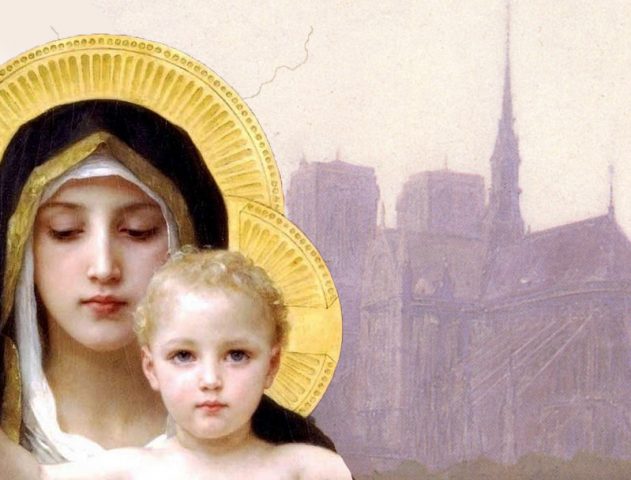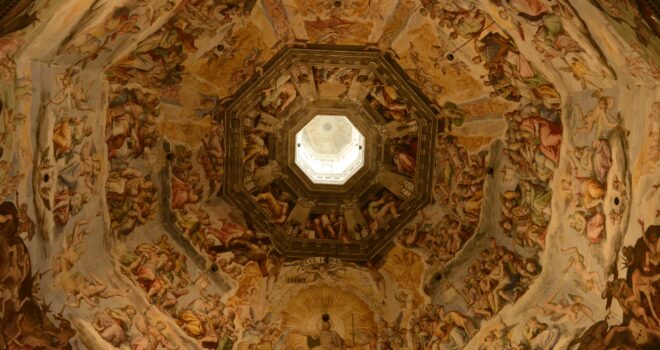Msgr. Charles Pope: What Does Jesus Mean When He Tells Mary Magdalene Not to Cling to Him Because He Has Not Yet Ascended?
April 23, 2019Immoderate Desires IV: The Deadly Sin of Envy
April 23, 2019
Vive la Cathédrale Notre-Dame de Paris!
By Msgr. Charles Pope, EWTN News, 4/22/19
The burning of Notre Dame in Paris last week struck us all very deeply, more deeply, I think, than most of us imagine. Even the most secular in France were struck and saddened. Why is this? Simply put, Notre Dame is far more than a building. What follows are three short reflections on the deeper meanings of the burning of Notre Dame. What unites them is an archetypal longing for what we once were and have seemingly lost but can regain if we allow Our Lady to lead us back to her Son.
She is Notre Dame de Paris.
This is more than a mere title or name. She is Our Lady of Paris. Yes, she is Our Lady, not merely a building but also a visible representation of our loving Blessed Mother in the center of Paris. In her womblike center she shelters Our Lord in the Most Blessed Sacrament. In the beautiful arms of her transept she has embraced millions since her construction in the 12thcentury. She has welcomed them and fed them spiritually, saying to her Son, “They have no wine.” In her aisles she has led them to Christ and from her pulpits she has said of her Son, “Do whatever He tells you.” She mourns with us in the beautiful pietà in the apse and rejoices with us through her choirs and the magnificent pipe organ in the gallery. Like any good mother, she tells us bible stories, not only from her pulpit but by her sermons in stone and stained glass. She reminds us of and unites us to our brothers and sisters, the saints, whose likenesses are all about her in statuary, tapestry, painting, and glass. Like the home of any noble lady and wonderful mother, Notre Dame is adorned with flowers—three of the most beautiful rose windows in the world.
Yes, she is Our Lady, Notre-Dame de Paris. As the fire tore through her rafters, a strange and primal feeling gripped all of us, believers and secularists. This was no mere building; this was Our Lady of Paris—a sign of Mother Mary and Mother Church. Whether a person loves his mother or is alienated from her, he can never really be free of her. No one could watch dispassionately as she burned.
She was one of the fairest flowers of the High Middle Ages.
She was built not merely of stones and medieval ingenuity but faith. The 13th and 14th centuries were, in many ways, the high-water mark of Christendom in Europe. It was endowed with what many today call “medieval synthesis,” for many of the things we in the modern age consider disconnected were seen as connected during the Middle Ages: faith and reason, Church and State, belief and the arts, theology and philosophy, church discipleship and state citizenship. It was certainly not a sin-free period, but faith was connected to almost everything. At the center of almost every town, village, or city was a church, and it was usually the tallest, most prominent, and most beautiful building.
Most of the medieval cathedrals were the skyscrapers of their time, soaring far above all else around them. The resources and time needed to build them was enormous, but to God be the glory! There was surely some human competitiveness at work as well. Notre Dame in Paris was rivaled by St Dénis, Chartres, Bourges, and many other magnificent structures that thrust heavenward; cities often sought to outdo one another. Competitive though it was, it was ultimately about building something to honor God. They gave and did their best for God.
It is very popular today to criticize the Catholic Church and Christian faith in general. Some of our history, to be sure, is far from noble. Yes, we have been sinful, but we have also, by God’s grace, given and done much of beauty and love. From Christendom and the Catholic Church come a great moral tradition that formed the basis of modern law and justice. Monasteries and their great scriptoriums and libraries, universities and their academic heritage, hospitals and their legacy of care and medical science, theology’s insistence on a rational and loving God, distinct from his creation but also immanent, helped form the basis for the scientific method and modern educational techniques. The glory of Church music, painting, sculpture, and many more things form a legacy and artistic treasure. All these things have shaped the Western World and even made modernity possible.
Notre Dame in Paris stands forth as a shining example of the intersection of faith, beauty, ingenuity, technology, and architecture. Its soaring, slender walls supported by flying buttresses and carefully designed arches were marvels of their day. The careful symmetry of the walls and ceilings bespoke an orderly faith, and the whimsical gargoyles and colorfully painted interiors displayed a medieval imagination that was anything but the “dark ages.” Faith was the golden cord woven throughout.
The Cathedral of Notre Dame did not simply appear out of nowhere. She is the fair flower of a great age of faith. To attempt to see the building as anything less is fanciful at best and disingenuous at worst. It is not simply a museum or a national symbol; it is an expression of Catholic faith and a reminder of what faith can inspire and offer. Though it may contain many artistic treasures, it was built to house something, Someone, far greater: the Most Blessed Sacrament; the Body, Blood, Soul, and Divinity of Jesus Christ. He is a treasure far greater than any other. He is meant to dwell there in sinu Maria, in the “womb” of Our Lady of Paris.
She tells France, Europe, and all of us what we once were.
While it is true that fundamental human nature does not change, how we perceive the world and ourselves has changed dramatically.
The people of the Middle Ages that built Notre Dame had different priorities than we do today. They had larger families yet lived in smaller, simpler homes. The church was most often the largest and most prominent building in the town or city. They were poorer than we are by far and yet constructed these edifices. Even in the United States, until the mid-20thcentury, poor immigrant communities built elaborate cathedral-like structures. Today we are far more affluent; we have smaller families yet live in larger homes. Our churches are often insignificant, while government buildings and places of commerce are prominent, elaborate, large, and tall.
The medieval world was enchanted. God, angels, and demons were experienced as having a prominent function in day-to-day activities. Their calendar was a sanctoral one, centered around the great feasts of the Church and the saints. They were a spiritual people, almost to a fault due to superstitions that might beset them. Faith was a shared, communal experience—not the personal, self-designed notion of religion that is common today. For them, heresy was akin to treason, and they understood the way that it destroys unity and endangers souls. They also thought far more about their last end: death, judgment, Heaven, and Hell. They prayed and fasted more frequently. They took God seriously, far more seriously than we do today.
Notre Dame and churches like it witness this to us, saying, “This is what we were once like.” Indeed, we were once very different. The Middle Ages were not idyllic, but neither were they the “dark ages” scoffed at by so many of the uninformed. A simple visit to Notre Dame shows a time replete with lofty images, colorful stained glass, and vivid imagination. The rose windows are not just pretty, they bespeak a vision centered on and revolving around Christ. The whole of her architecture shows an appreciation of order, symmetry, balance, and strength.
It is amazing that such magnificent buildings could be erected without modern machines and instruments. A lot of the measurements were eyeballed; large stones were raised one by one to dizzying heights after having been hauled long distances from quarries. This testifies to a dedication to and perseverance in a task of almost a hundred years involving the assets and manpower of entire towns focused on the center of their lives, the Catholic faith.
Yes, Notre Dame says to us that we were once very different in terms of our priorities, our faith, and how we see ourselves and the world. Its burning reminds us that what has been damaged is not just a building but our collective soul.
In tumultuous times like these there will surely be debates about what the “new” Notre Dame should be like. Should it reflect something of “us,” or should it continue to reflect what we once were? I say, of course, the latter, for we would never undertake to build such a structure today.
It is heartwarming to see the generous donations that have come forth, but I fear many people want to restore a museum or historical monument rather than a living center and beating heart of faith. She is not a museum or monument; she is Notre Dame, Our Lady. She is living, for she gathers the members of Christ’s own mystical Body. She embraces His Eucharistic presence within her, and she speaks to us in these tender words: “Here is my Son, listen to Him.”
I can only pray that even the secular denizens of France will realize that they wept for more than a building; they wept for their mother, Notre Dame. The tears we shed and the angst we felt as that fire rages were more primal, more archetypal, than we might first imagine. I am convinced that we also wept with and for our Lady and for the best of what we once were. We were surely not perfect, but we were once better than we are today: more spiritual, more centered on what really matters, more aware of our sins, and more cognizant of our need for grace. So, we built a grand image of Our Lady calling us to her Son. That is what we once did and what we should now restore through rebuilding and the repentance of spiritual renewal.
Vive la Cathédrale Notre-Dame de Paris!







